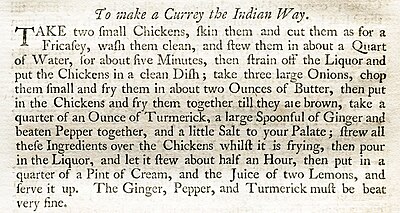Anglo-Indian cuisine
| British cuisine |
|---|
| National cuisines |
| Regional cuisines |
| Overseas/Fusion cuisine |
| People |
|
|
| This article is part of the series on |
| Indian cuisine |
|---|
 |
Anglo-Indian cuisine is the cuisine that developed during the British Raj in India.[1] The cuisine introduced dishes such as curry, chutney, kedgeree, mulligatawny and pish pash to English palates.
Anglo-Indian cuisine was documented in detail by the English colonel Arthur Robert Kenney-Herbert, writing as "Wyvern" in 1885 to advise the British Raj's memsahibs what to instruct their Indian cooks to make.[1][2] Many of its usages are described in the "wonderful"[1] 1886 Anglo-Indian dictionary, Hobson-Jobson.[1] More recently, the cuisine has been analysed by Jennifer Brennan in 1990 and David Burton in 1993.[1][3][4][5]
History
During the
The

Many cookbooks including Indian-style dishes were written and published by British women in the late 18th century,[16] such as Hannah Glasse's 1758 book The Art of Cookery Made Plain and Easy, which included the recipe "To make a Currey the Indian Way".[17]
As Indian cuisine grew in popularity in Britain, the desire for authentic Indian delicacies grew. In March 1811, the Hindoostane Coffee House opened in Portman Square offering Indian ambience and curries as well as hookah smoking rooms.[18] The founder, Sake Dean Mohomed, stated that the ingredients for the curries as well as the herbs for smoking were authentically Indian.[19]
Dishes
Well-known Anglo-Indian dishes include chutneys,
Pish pash was defined by Hobson-Jobson as "a slop of rice-soup with small pieces of meat in it, much used in the Anglo-Indian nursery". The term was first recorded by Augustus Prinsep in the mid 19th century.[22] The name comes from the Persian pash-pash, from pashidan, to break.[23] A version of the dish is given in The Cookery Book of Lady Clark of Tillypronie of 1909.[1]
Restaurants
Some early restaurants in England, such as the Hindoostane Coffee House on George Street, London, which opened in 1810, served Anglo-Indian food. Many Indian restaurants, however, have reverted to the standard mix-and-match Indian dishes that are better known to the British public.
References
- ^ ISBN 978-0-19-967733-7.
- ISBN 0-907325-55-6.
- ^ Brennan, Jennifer (1990). Encyclopaedia of Chinese and Oriental Cookery. Black Cat.
- ISBN 962-593-818-4.
- ^ Burton, David (1993). The Raj at Table. Faber & Faber.
- ^ "Sustainable shore - October recipe - Year of Food and Drink 2015 - National Library of Scotland". nls.uk.
- ^ JSTOR 20764390.
- ^ "Cooking under the Raj". Retrieved 30 January 2008.
- British Broadcasting Corporation. Retrieved 27 September 2016.
"Indian dishes, in the highest perfection… unequalled to any curries ever made in England." So ran the 1809 newspaper advert for a new eating establishment in an upmarket London square popular with colonial returnees.
- ^ The Epicure's Almanack, Longmans, 1815, pages 123-124.
- ISBN 978-1-905-21185-2.
- ^ Metcalf 2014, p. 44.
- ^ Metcalf 2014, p. 56.
- S2CID 159799417. Retrieved 8 November 2023.
- ^ S2CID 146364557.
- ^ S2CID 142731887.
- The Art of Cookery made Plain and Easy. Edinburgh. p. 101.
- ^ Collingham 2007, p. 129.
- ^ Collingham 2007, p. 2.
- ^ "Sustainable shore - October recipe - Year of Food and Drink 2015 - National Library of Scotland". nls.uk.
- ^ Bateman, Michael (17 August 1996). "Chutneys for Relishing". The Independent. Archived from the original on 7 May 2022. Retrieved 26 September 2016.
- ^ "pish-pash". Oxford Dictionaries. Archived from the original on 2 February 2017. Retrieved 22 January 2017.
- ISBN 978-0-19-967733-7.
Sources
- Collingham, Lizzie (2007). Curry: A tale of cooks and conquerors. Chapter 1: Chicken Tikka Masala: The Quest for an Authentic Indian Meal, Chapter 6: Curry Powder: Bringing India to Britain: Oxford University press. p. 129.
{{cite book}}: CS1 maint: location (link) - Metcalf, Barbara (2014). A Concise History of Modern India. Cambridge University Press. ISBN 9781139207805.
Further reading
- Patricia Brown (24 February 1998). Anglo-Indian Food and Custom. Penguin Books India. ISBN 0-14-027137-6.
- Henrietta Hervey (2006) [1895]. A Curry Book (Anglo-Indian Cookery at Home). Ludlow: Excellent Press. ISBN 978-1-900318-33-4.
- ISBN 0-340-68035-0.
External links
- "Food Stories" Archived 10 April 2021 at the Wayback Machine — Explore a century of revolutionary change in UK food culture on the British Library's Food Stories website
- "How Britain got the hots for curry". BBC News Magazine. 26 November 2009. Retrieved 15 August 2014.
- "Fears for the decline of Anglo-Indian cooking". BBC News Online. 7 February 2011. Retrieved 15 August 2014.
- "Indian Food" — Authentic Indian Cuisine in the UK.
- "Best Indian Restaurant in London" — Have a look to the best Indian food restaurants in London to the History_of_Indian_cuisine's Holy Cow website
